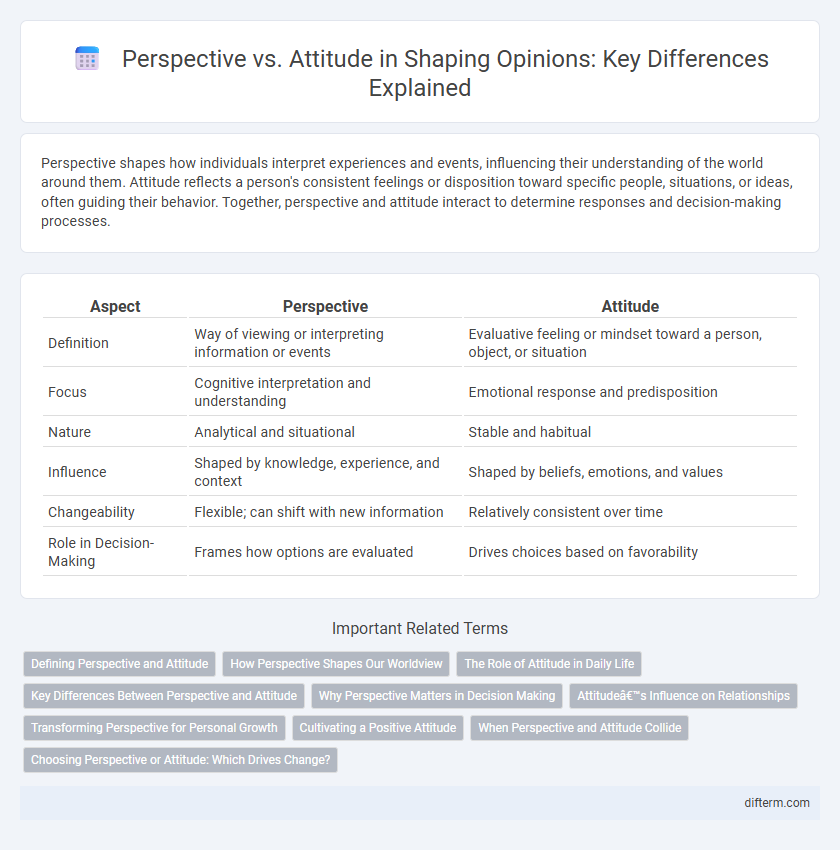Perspective shapes how individuals interpret experiences and events, influencing their understanding of the world around them. Attitude reflects a person's consistent feelings or disposition toward specific people, situations, or ideas, often guiding their behavior. Together, perspective and attitude interact to determine responses and decision-making processes.
Table of Comparison
| Aspect | Perspective | Attitude |
|---|---|---|
| Definition | Way of viewing or interpreting information or events | Evaluative feeling or mindset toward a person, object, or situation |
| Focus | Cognitive interpretation and understanding | Emotional response and predisposition |
| Nature | Analytical and situational | Stable and habitual |
| Influence | Shaped by knowledge, experience, and context | Shaped by beliefs, emotions, and values |
| Changeability | Flexible; can shift with new information | Relatively consistent over time |
| Role in Decision-Making | Frames how options are evaluated | Drives choices based on favorability |
Defining Perspective and Attitude
Perspective refers to the cognitive viewpoint shaped by experiences, beliefs, and knowledge that influences how individuals interpret information and events. Attitude encompasses the emotional and evaluative stance toward people, objects, or concepts, often manifesting as positive, negative, or neutral feelings. Understanding the distinction clarifies how perspective guides perception while attitude drives behavioral responses.
How Perspective Shapes Our Worldview
Perspective shapes our worldview by influencing how we interpret experiences and information, guiding our judgments and decisions. Unlike attitude, which reflects our internal feelings and predispositions, perspective provides the broader lens through which we analyze and understand different situations. This cognitive framework affects cultural perceptions, personal biases, and the way we engage with diverse ideas, ultimately shaping our reality.
The Role of Attitude in Daily Life
Attitude shapes daily interactions and decisions by influencing how individuals perceive and respond to various situations, serving as a lens through which experiences are interpreted. Unlike perspective, which refers to one's viewpoint or angle of understanding, attitude embodies the emotional and behavioral disposition that drives actions. Positive attitudes foster resilience and proactive behavior, playing a critical role in managing stress and enhancing social relationships.
Key Differences Between Perspective and Attitude
Perspective shapes how individuals interpret experiences based on their beliefs and values, creating a cognitive framework for understanding the world. Attitude reflects the emotional response and behavioral tendencies toward people, objects, or situations, often influenced by personal feelings. The key difference lies in perspective being more about perception and worldview, while attitude directly affects actions and reactions.
Why Perspective Matters in Decision Making
Perspective shapes how individuals interpret information and evaluate options, directly influencing the quality of decisions made. A varied perspective introduces diverse insights and reduces biases, leading to more balanced and effective outcomes. Emphasizing perspective over attitude fosters open-mindedness and adaptability in complex decision-making environments.
Attitude’s Influence on Relationships
Attitude plays a pivotal role in shaping interpersonal relationships by influencing communication patterns, emotional responses, and conflict resolution strategies. Positive attitudes foster trust, empathy, and mutual respect, thereby strengthening relational bonds and supporting long-term connection. Negative attitudes, on the other hand, can lead to misunderstandings, emotional distance, and increased tension, undermining the stability and quality of relationships.
Transforming Perspective for Personal Growth
Transforming perspective enhances personal growth by enabling individuals to reframe challenges as opportunities, fostering resilience and adaptability. Shifting viewpoint promotes self-awareness and emotional intelligence, which are crucial for overcoming limiting beliefs and achieving long-term success. Emphasizing a growth-oriented perspective over a fixed attitude leads to continuous learning and meaningful life changes.
Cultivating a Positive Attitude
Cultivating a positive attitude requires intentional effort to reshape internal perspectives and embrace optimism. Unlike perspective, which involves objective viewpoints shaped by experience, attitude reflects emotional responses that drive behavior and motivation. Strengthening a positive attitude fosters resilience, enhances mental well-being, and improves interpersonal relationships by promoting constructive interactions.
When Perspective and Attitude Collide
When perspective and attitude collide, the resulting conflict often stems from deeply ingrained beliefs shaping how individuals interpret the same situation. Perspective represents the lens filtered through experiences and knowledge, whereas attitude reflects the emotional stance or disposition toward that viewpoint. Understanding this distinction is crucial for resolving disagreements and fostering open-minded communication.
Choosing Perspective or Attitude: Which Drives Change?
Choosing perspective over attitude significantly influences the trajectory of change by shaping how individuals interpret situations and possibilities. Perspective provides a broader cognitive framework that guides decision-making and problem-solving, while attitude reflects an emotional stance that may limit adaptive responses. Fostering a flexible perspective enables proactive innovation and resilience, driving sustainable transformation more effectively than a fixed attitude.
perspective vs attitude Infographic

 difterm.com
difterm.com